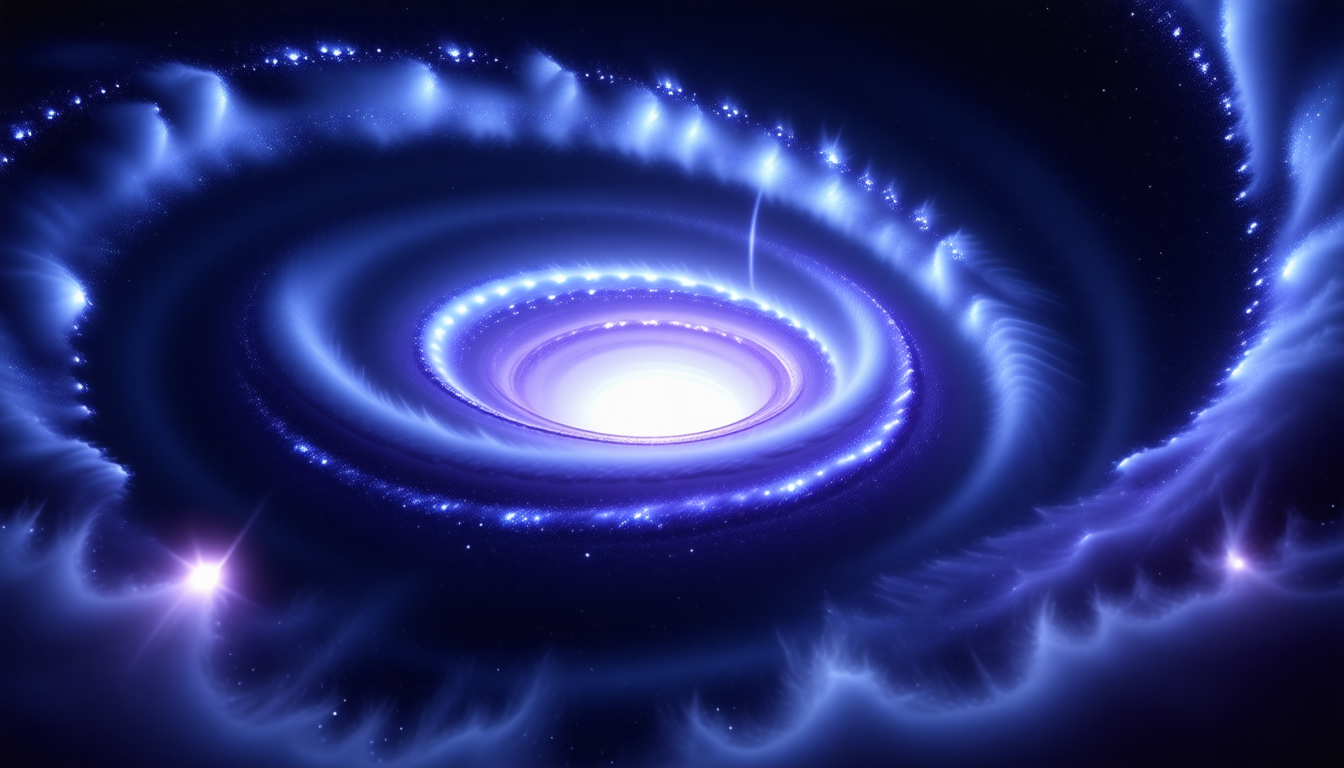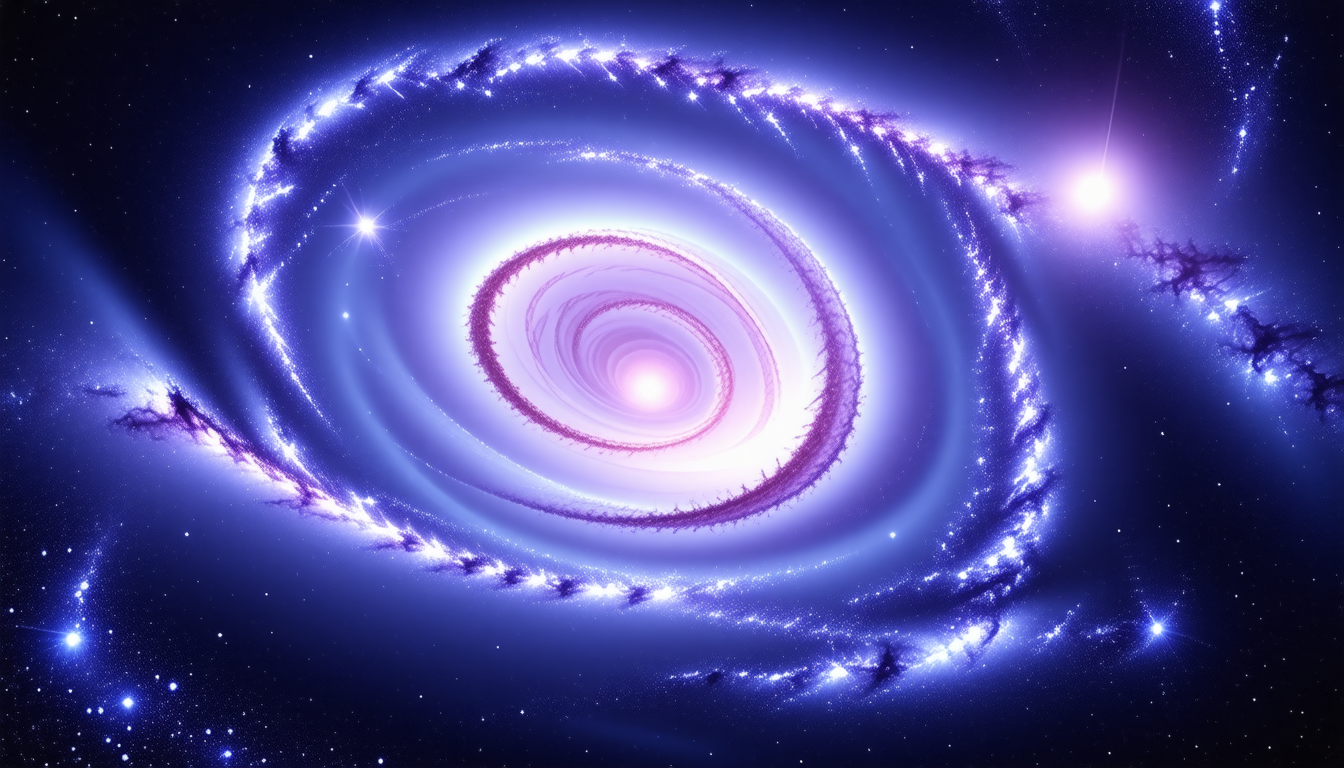Unraveling the Cosmic Tapestry

The mysteries of cosmic structures and forces
The universe stands as an enigmatic canvas painted with the intricate brushstrokes of cosmic structures and forces. Within this grand design lie the vast arrays of galaxies woven into filaments, clusters, and voids, creating a breathtaking cosmic tapestry. At the heart of this architecture is gravity, a force that shapes the very essence of our universe, binding everything from the smallest particles to the largest galaxies together.
Galactic Structures and the Cosmic Web
The cosmic web represents the largest-scale structure of the universe, arising from the gravitational clumping of matter. Initially, after the Big Bang, the universe was nearly uniform in density. Over time, however, small fluctuations in this density magnified under gravity’s influence, creating regions of attraction. The interplay of dark matter—an invisible substance making up about 27% of the universe—and ordinary baryonic matter led to the formation of intricate filaments. These filaments, teeming with galaxies, often connect vast cosmic structures like clusters and superclusters. Between these clusters reside enormous voids, largely empty areas that seem almost haunting in their solitude.
This distribution highlights a key aspect of the universe’s evolution: the tendency of gravitational forces to gather matter into dense regions. The alignment and distribution patterns of galaxies help astronomers understand the formation and dynamics of the universe. Recent studies reveal that these cosmic structures are not merely random arrangements but reflect the complex gravitational interactions at play, dictating how galaxies cluster together and how voids expand.
The Role of Dark Matter
Dark matter is a cornerstone of cosmological models, influencing the organization of matter throughout the universe. Although it does not emit, absorb, or reflect light, its presence can be inferred through its gravitational effects. For instance, the rotation curves of galaxies—observations revealing the speed at which stars orbit their galactic centers—disagree with predictions based solely on visible matter. The existence of dark matter provides the additional mass needed to explain these observations, suggesting an important stabilizing role in the formation of galaxies and the retention of their structures.
Furthermore, dark matter’s gravitational influence becomes vital during the universe’s formative years. After the initial cosmological expansion, as galaxies began to form, dark matter created a “scaffolding” around which gas and ordinary matter accumulated. This process was paramount in shaping the cosmic web we observe today, contributing to both the development of matter-dense regions and vast, nearly empty voids. The understanding of dark matter and its properties remains a tantalizing area of research, as scientists pursue ways to detect its existence more directly, potentially unlocking new dimensions of understanding concerning the universe’s structure and history.
The Forces at Work
Not only does gravity bind cosmic structures, but it also operates alongside other fundamental forces that shape our understanding of the universe. Electromagnetism, the strong nuclear force, and the weak nuclear force govern interactions within individual atoms and across larger scales. This delicate interplay of forces serves as a reminder of how intricately connected all elements of the universe are.
The gravitational influence of massive celestial bodies like supermassive black holes at the centers of galaxies can impact star formation rates and gas dynamics in their surrounding areas. These black holes, with masses millions to billions of times that of our Sun, act as gravitational well points, shaping the dynamics of galaxy formation and influencing their evolutionary paths.
Voids and Cosmic Evolution
The study of cosmic voids—areas notably devoid of galaxies—serves to further illustrate the complexity of cosmic structures. Voids can extend over hundreds of millions of light-years, standing in stark contrast to the densely populated filaments of galaxies surrounding them. Their existence plays an important role in the overall understanding of cosmic evolution; by studying voids, scientists glean insights into the impact of dark energy on the universe’s expansion dynamics. The growth and characteristics of these voids provide critical information regarding the distribution and evolution of matter in the cosmos over time.
All in all, the mysteries of cosmic structures and forces propel astronomers and physicists into a realm of inquiry that stretches the boundaries of human understanding. As we delve into the intricacies of the gravitational web binding the universe together, we not only seek answers to age-old questions about our origins but also confront the fundamental properties that govern the fabric of reality itself. The quest to understand the cosmos is never-ending—a journey filled with discovery and enlightenment, as new observations continuously prompt us to reevaluate what we know about the vast universe we inhabit.

Anomalies and unexplained phenomena in the universe
The cosmos is riddled with anomalies and unexplained phenomena that challenge our understanding of reality. These mysteries not only fascinate scientists but also invoke deeper philosophical musings about the very nature of existence. Our exploration of the strange and unpredictable aspects of the universe reveals a complex interplay between physical laws and cosmic events, where the known often collides with the unknown.
The Cosmic Microwave Background and Its Anomalies
One of the most intriguing relics from the early universe is the cosmic microwave background (CMB) radiation—a faint echo from the Big Bang that permeates all of space. While the CMB is mostly uniform, slight anisotropies in its temperature have been detected, hinting at the fluctuations that seeded the formation of galaxies. Among these anomalies is the so-called “Axis of Evil,” a peculiar alignment of large-scale cosmic structures that seems to point towards a specific direction in space. Such an alignment is unexpected and raises questions about its origins. Could it be mere coincidence, or does it demand a revision of our cosmological models? This pattern invites further investigation and has prompted debates among cosmologists about the fundamental principles underpinning our understanding of the universe.
The Cold Spot: A Cosmic Mystery
Another notable anomaly is the “Cold Spot,” a large area of the cosmic microwave background that appears significantly cooler than the surrounding regions. This chilly patch spans about 10 degrees in the sky and has piqued the curiosity of researchers since its discovery. Several theories have been proposed to explain its origins. One possibility suggests it might be a supervoid—an enormous region of space with far fewer galaxies than average, which could lead to cooler temperatures in the CMB as light traverses this underpopulated area. Alternatively, it could point to yet-unrealized fluctuations from the conditions of the early universe, or even suggest a potential connection to the existence of other universes in a broader multiverse framework. Each hypothesis digs deeper into the complexities of cosmic evolution and the unknown forces shaping our universe.
Galactic Voids and Their Significance
The exploration of cosmic voids—vast, nearly empty expanses where virtually no galaxies reside—offers additional insights into the dynamics of the universe. These voids can stretch across billions of light-years and serve as a testament to the uneven distribution of matter in the cosmos. Their presence underscores the importance of understanding how gravity works on both large and small scales. As astronomers study these voids, they gain insights into the nature of dark energy and its effects on the universe’s expansion. Anomalies in the distribution and growth of these voids suggest that there are intricate processes at play, potentially reshaping our understanding of cosmic evolution.
The Great Attractor
The Great Attractor represents another cosmic enigma—a gravitational anomaly in the direction of the constellation Centaurus that influences the motion of galaxies in our local supercluster. This compelling zone appears to draw galaxies, including our Milky Way, toward it at astonishing velocities. Yet, because the Great Attractor is obscured by the dense gas and dust of the Milky Way’s galactic plane, studying it has proven challenging. The mass concentration believed to reside in this region could reveal new dimensions of gravitational dynamics and the interconnectedness of cosmic structures.
Gamma Ray Bursts and the Search for Answers
Among the most violent phenomena in the universe are gamma-ray bursts (GRBs)—extraordinarily energetic explosions that occur in distant galaxies. GRBs can release energy in mere seconds equivalent to that emitted by the Sun over billions of years. Their exact origins remain partially shrouded in mystery, with current theories suggesting connections to the collapse of massive stars or the merger of compact objects such as neutron stars and black holes. The quest to understand GRBs not only illuminates aspects of stellar evolution and death but also offers opportunities to probe deeper into the mechanics of the cosmos.
Fast Radio Bursts: Extraterrestrial Signals or Cosmic Mysteries?
Fast radio bursts (FRBs), powerful and fleeting flashes of radio waves from distant galaxies, represent another frontier of cosmic mystery. Since their discovery, scientists have been captivated by their origins—each burst lasts only a few milliseconds yet can unleash energy comparable to that of the Sun over a day. The varied characteristics of FRBs invoke a spectrum of theories ranging from cataclysmic astrophysical events to the tantalizing suggestion that they could be signals from advanced alien civilizations. As researchers refine their observational capabilities, deciphering the nature of these bursts has potential implications for our understanding of cosmic processes and the search for extraterrestrial life.
The pursuit of answers concerning these anomalies reflects humanity’s intrinsic curiosity and desire to unravel the universe’s secrets. Each discovery, while potentially elucidating some mysteries, often leads to further questions, emphasizing the vast and intricate complexity of cosmic phenomena. In this grand tapestry of existence, the unanswered questions remind us that there is still much to learn about the universe and our place within it, inspiring continued exploration and inquiry into its unfathomable depths.

The search for extraterrestrial life and consciousness
The search for extraterrestrial life and the nature of consciousness represents one of the most profound inquiries of human existence, driving our scientific pursuits and philosophical reflections. As we gaze into the night sky, we are confronted with the overwhelming vastness of the cosmos, leading us to consider whether we are alone in this grand expanse or if other forms of conscious life exist beyond our understanding.
Exoplanets and the Search for Habitable Worlds
Recent advances in astrophysics have led to the discovery of thousands of exoplanets, some of which occupy the habitable zones of their stars—regions where conditions may be just right for liquid water to exist, an important ingredient for life as we know it. Proxima Centauri b, for example, orbits our closest neighboring star and dwells within this promising region. However, the mere existence of liquid water does not guarantee the presence of life; the chemical composition of atmospheres, the presence of magnetic fields, and other factors play equally vital roles in determining a planet’s capacity to host biological processes. The investigation of such worlds, particularly through future telescopes designed to analyze atmospheres for biosignatures—indicators of life—remains a captivating frontier in our search for extraterrestrial intelligence.
The Unique Case of Mars and Europa
The search for microbial life within our own solar system has intensified, particularly on Mars and Europa, a moon of Jupiter. Mars has shown previous signs of liquid water, with recent missions revealing evidence of ancient riverbeds and mineral deposits formed in watery environments. The Curiosity and Perseverance rovers are tasked with discerning whether these environments could have supported life, seeking biosignatures to provide hints of past biological activity. Moreover, the discovery of seasonal methane fluctuations in the Martian atmosphere—a gas often associated with biological processes—has added yet another layer of intrigue.
Europa, with its icy crust concealing a vast subsurface ocean, presents an even more tantalizing prospect. Gravitational interactions with Jupiter keep this ocean warm, potentially providing an environment conducive to life. The upcoming NASA Europa Clipper mission aims to explore the moon’s habitability by studying its surface and subsurface, enhancing our understanding of the potential for life existing outside Earth.
The Search for Extraterrestrial Signals
The quest for extraterrestrial intelligence drives astronomers to scour the cosmos for signals that may indicate advanced civilizations. Programs such as SETI (Search for Extraterrestrial Intelligence) utilize sophisticated technology to monitor radio waves across the sky for patterns that suggest artificial origins. Notably, signals such as the Wow! signal, detected in 1977, have fueled speculation about contact with an intelligent source, even though the signal has never been observed again.
Fast Radio Bursts: Signals of Life or Cosmic Mysteries?
Fast radio bursts (FRBs) have emerged as one of the most intriguing phenomena in the search for extraterrestrial civilization. These intense radio waves, though brief, emit energy comparable to that radiated by the Sun in an entire day. While the exact origins of FRBs remain unclear—ranging from highly magnetized neutron stars to exotic astrophysical events—the speculation surrounding the potential for these bursts to be signals from intelligent life adds a layer of excitement to this cosmic enigma. Researchers are now analyzing the characteristics of these bursts to discern whether they’re products of natural cosmic events or perhaps something far more extraordinary.
Philosophical Musings on Consciousness
The search for extraterrestrial life intertwines with deeper philosophical inquiries concerning consciousness itself. Questions arise about what it means to be conscious and whether consciousness is an exclusive trait of biological entities or whether it can be a property of artificial systems as well. Theories propose that if artificial intelligence or synthetic life were created, it might possess forms of consciousness distinct from our own, reshaping our understanding of sentience.
Moreover, if consciousness is a fundamental part of the universe, as some theories suggest, it raises profound questions about our interconnectedness with the cosmos. What if consciousness is an intrinsic aspect of reality itself? Might all particles possess some form of experience, leading to the emergence of larger consciousness at higher levels of complexity?
As we pursue our quest for extraterrestrial life, we are at once journeying through the realms of philosophical debate and scientific inquiry. Each breakthrough enhances our understanding of the delicate interplay between consciousness and existence, prompting deeper reflections on our own understanding of life, the universe, and everything in between. The unraveling of these mysteries will define not only human aspirations for knowledge but will also sculpt the very narrative of our species as we strive to understand our place within the vast cosmic tapestry.
The implications of dark matter and dark energy on cosmic evolution
The implications of dark matter and dark energy on cosmic evolution are profound, shaping not only the destiny of galaxies and clusters but also our understanding of the universe itself. Dark matter, which constitutes nearly 27% of the total mass-energy content, plays a vital role in influencing the formation and structural integrity of cosmic structures. This invisible matter does not emit, absorb, or reflect light, rendering it undetectable through conventional means. Instead, it exerts its influence gravitationally, acting as a scaffold upon which galaxies and clusters can form and evolve.
Through the lens of dark matter, we comprehend the universe as a complex web of interactions. It enhances our grasp of galaxy formation by providing the gravitational foundation necessary for gas and baryonic matter to coalesce. Observational evidence demonstrates that galaxies are distributed along the filaments of the cosmic web, with both dark and visible matter working in tandem to shape the evolutionary narrative of the cosmos. Indeed, without dark matter, the gravitational pull required to form galaxies would be insufficient, explaining why spiral galaxies rotate at such unexpected speeds when contrasting the distribution of visible matter alone.
In addition to its structural contributions, dark matter influences large-scale cosmic processes. Its presence is pivotal in the growth of cosmic structures, dictating how galaxies cluster and evolve within the fabric of the universe. The gravitational lensing effect—wherein the path of light is bent by massive objects—further underlines dark matter’s role in revealing the dynamics of cosmic evolution. Through advanced observational techniques, such as those utilized by the Hubble Space Telescope, we have been able to map dark matter’s presence by studying the distortions it creates as light travels through the universe. These insights allow astronomers to paint a picture of an interconnected cosmic web filled with dark matter that governs the movement and accumulation of ordinary matter.
On the other hand, dark energy, making up about 68% of the universe’s total energy density, radically alters the course of cosmic evolution by driving the universe’s accelerated expansion. First discovered in the late 1990s through observations of distant supernovae, dark energy challenges our understanding of gravity and the laws governing cosmic dynamics. Its presence propels galaxies further apart at an ever-increasing rate, reshaping the universe’s structure over time.
The implications of dark energy extend into a high number of realms of inquiry, including questions about the ultimate fate of the universe. Various hypotheses concerning dark energy envision a universe heading towards a “Big Freeze,” where galaxies drift apart into a vast, dark, and cold isolation. Alternatively, if the influence of dark energy continues to escalate, some scientists contemplate scenarios like the “Big Rip,” where the fabric of the universe itself unravels under the relentless force of this enigmatic energy.
As we delve deeper into the nature of dark energy, potential links between dark matter and dark energy arise, suggesting that these constituents of the universe may be interconnected in ways currently beyond our comprehension. Theoretical models propose intriguing possibilities where dark energy’s repulsive behavior could interact with dark matter, influencing cosmic structures in unforeseen ways. Such connections might hint at a deeper layer of reality that calls for reevaluation of established cosmological paradigms.
Alongside unraveling the intricacies of dark matter and dark energy, researchers are exploring how these phenomena impact future cosmic evolution. Understanding their characteristics, behaviors, and interactions is essential for unraveling the timeline of our universe. The cosmic evolution we observe today is a delicate dance of decay and growth, wherein dark matter clusters provide stability, and dark energy fuels expansion, embodying two sides of the same cosmic coin. In the quest to unveil the universe’s secrets, both dark matter and dark energy remain at the forefront of scientific investigation, promising to reveal deeper insights into the fundamental architecture of the cosmos.